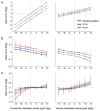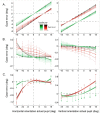Optics of the human cornea influence the accuracy of stereo eye-tracking methods: a simulation study
- PMID: 28270978
- PMCID: PMC5330588
- DOI: 10.1364/BOE.8.000712
Optics of the human cornea influence the accuracy of stereo eye-tracking methods: a simulation study
Abstract
Current stereo eye-tracking methods model the cornea as a sphere with one refractive surface. However, the human cornea is slightly aspheric and has two refractive surfaces. Here we used ray-tracing and the Navarro eye-model to study how these optical properties affect the accuracy of different stereo eye-tracking methods. We found that pupil size, gaze direction and head position all influence the reconstruction of gaze. Resulting errors range between ± 1.0 degrees at best. This shows that stereo eye-tracking may be an option if reliable calibration is not possible, but the applied eye-model should account for the actual optics of the cornea.
Keywords: (330.2210) Vision - eye movements; (330.4460) Ophthalmic optics and devices; (330.7326) Visual optics, modeling.
Figures









References
-
- Poole A., Ball L. J., “Eye Tracking in Human-Computer Interaction and Usability Research: Current Status and Future Prospects,” in Encyclopedia of Human-Computer Interaction, Ghaoui C., ed. (Idea Group Reference, 2005), pp. 211–219.
-
- Wade N., Tatler B., The Moving Tablet of the Eye: The Origins of Modern Eye Movement Research (Oxford University Press, 2005).
-
- Holmqvist K., Nyström M., Andersson R., Dewhurst R., Jarodzka H., Van De Weijer J., Eye Tracking: A Comprehensive Guide to Methods and Measures (Oxford University Press, 2011).
LinkOut - more resources
Full Text Sources
Other Literature Sources
